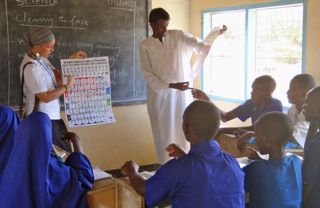Imagine growing up in a small village where your family herds goats and sheep. One morning while reading under a tree, you suddenly see your neighbors running in every different direction. Dust swirls around them and you smell smoke. In the distance, there are men with large guns in trucks and you see that your house is on fire. Out of nowhere, your older brother grabs your hand and pulls you to your feet. Women and children run past and you join the crowd as they rush from the chaos and fear. For days, you follow your brother’s lead, hungry and cold, until you reach Dadaab – the world’s largest refugee camp in Northeast Kenya.
This account is a familiar story told by many refugees that fled Somalia in the early 1990’s – with one exception. In this scene, you are deaf. You couldn’t hear the warning screams or gunshots. You couldn’t hear your mother’s cry or your neighbors deliberate over where to find safety. You couldn’t hear your older brother try to comfort you while you walked together.
Like with any population of half a million people, there is a large deaf community in Dadaab. Some refugees were born unable to hear while others become deaf from illnesses they contracted from a lack of proper vaccinations and medications. Ridiculed by their peers for being different, deaf refugees endure a high level of harassment in Dadaab and other refugee camps worldwide. The hearing community treats refugees who are deaf as inferior. It is not uncommon for people to throw stones at someone who is deaf either as a joke or to get his or her attention. Adults are overlooked for employment inside the camps and children are unable to communicate with their loved ones. Some residents even suggest that a refugee with any disability, including being deaf, must have done something wrong to deserve their ‘punishment.’
Unfortunately, people in the camp, including many aid workers, rarely make the attempt to communicate with the deaf community despite their high level of vulnerability. In fact, it is the deaf community itself that is making some of the greatest strides against the discrimination and inequality. Many youth in the deaf community become teachers within the schools and help other students learn how to sign. They also act as role models for the peers who cannot communicate with their relatives. For some students, their teachers are the only people they can communicate with in their lives.
For the past year, RefugePoint has also been actively engaged with the deaf community thanks to one of our Protection Officers who is fluent in Kenyan Sign Language (KSL). While working in the camp, Officer Megan DaPisa reached out to the Deaf population to learn more about their plight and how she could be helpful. Megan entered the camps often to work as an interpreter and co-advocate for their rights. She organized focus groups and communicated with NGO partners about the needs of the population. In her words, “It has been a privilege to get to know the deaf community and work with these individuals. They are some of the most resilient, positive people I know and I just wish more attention was focused on their needs.”
Megan’s last day with RefugePoint was June 6th. She is entering graduate school in the fall to pursue a master’s degree in social work; however, RefugePoint will continue to advocate for the deaf community in Dadaab and throughout Africa.
